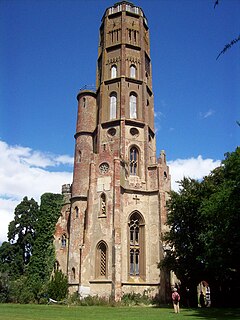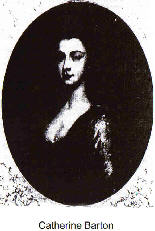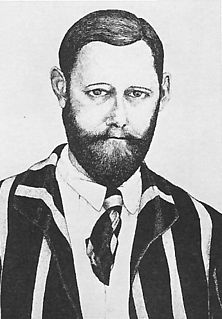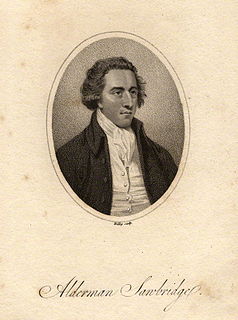Elias Pym Fordham (1788-1850) was the original surveyor of Indianapolis. He was an English immigrant to the United States and author of an American travel memoir.

Indianapolis, often shortened to Indy, is the state capital and most populous city of the U.S. state of Indiana and the seat of Marion County. According to 2017 estimates from the U.S. Census Bureau, the consolidated population of Indianapolis and Marion County was 872,680. The "balance" population, which excludes semi-autonomous municipalities in Marion County, was 863,002. It is the 16th most populous city in the U.S. The Indianapolis metropolitan area is the 34th most populous metropolitan statistical area in the U.S., with 2,028,614 residents. Its combined statistical area ranks 27th, with a population of 2,411,086. Indianapolis covers 368 square miles (950 km2), making it the 16th largest city by land area in the U.S.
Elias Pym Fordham was born in Royston, Hertfordshire, [1] one of two sons and seven children to Elias Fordham (1762-1838) and his first wife Ann Clapton. [2] The family background was of liberal nonconformism in Hertfordshire, exemplified by his uncle Edward King Fordham. He studied civil engineering under George Stephenson (a developer of the steam locomotive). [2]
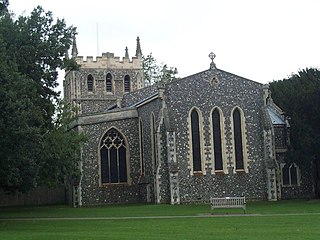
Royston is a town and civil parish in the District of North Hertfordshire and county of Hertfordshire in England.

Hertfordshire is one of the home counties in England. It is bordered by Bedfordshire and Cambridgeshire to the north, Essex to the east, Greater London to the south, and Buckinghamshire to the west. For government statistical purposes, it is placed in the East of England region.
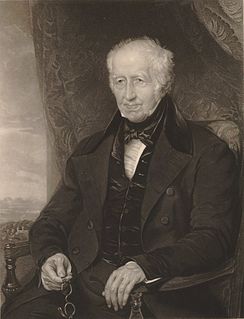
Edward King Fordham (1750–1847) was an English banker and political reformer.
Fordham immigrated to the US in 1817 with his sister Maria and travelled to Illinois where he purchased a tract of land in what was known as "the English Prairie", [2] settled also by his first cousin George Flower (1788-1862), a founder of Albion, Illinois. In April 1821 he along with Alexander Ralston received joint appointments as surveyors of Indianapolis. [2]

Illinois is a state in the Midwestern region of the United States. It has the 5th largest Gross Domestic Product by state, is the 6th-most populous U.S. state and 25th-largest state in terms of land area. Illinois is often noted as a microcosm of the entire United States. With Chicago in the northeast, small industrial cities and great agricultural productivity in northern and central Illinois, and natural resources such as coal, timber, and petroleum in the south, Illinois has a diverse economic base, and is a major transportation hub. Chicagoland, Chicago's metropolitan area, contains over 65% of the state's population. The Port of Chicago connects the state to other global ports around the world from the Great Lakes, via the Saint Lawrence Seaway, to the Atlantic Ocean; as well as the Great Lakes to the Mississippi River, via the Illinois Waterway on the Illinois River. The Mississippi River, the Ohio River, and the Wabash River form parts of the boundaries of Illinois. For decades, Chicago's O'Hare International Airport has been ranked as one of the world's busiest airports. Illinois has long had a reputation as a bellwether both in social and cultural terms and, through the 1980s, in politics.
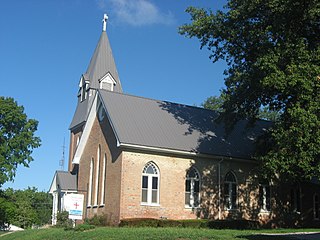
Albion is a city in and the county seat of Edwards County, Illinois, United States. The population was 1,988 at the 2010 census. The city was named "Albion" after an ancient and poetic reference to the island of Great Britain.
Alexander Ralston was a Scottish surveyor who was one of two co-architects for the design of the city of Indianapolis, Indiana. He also helped to design Washington, D.C.
Little else is known of Fordham. [2] He was well educated and articulate as evidenced by his Personal narrative of travels in Virginia, Maryland, Pennsylvania, Ohio, Indiana, Kentucky : and of a residence in the Illinois Territory: 1817-1818 which was not published until 1906 (now out of print). He eventually returned to England and continued working on projects with George Stephenson. [2] On 16 Jul 1832 he obtained a licence to marry a widow, Priscilla Ebenezer Morris at Dover. [3]

Dover is a major ferry port in Kent, South East England. It faces France across the Strait of Dover, the narrowest part of the English Channel, and lies south-east of Canterbury and east of Maidstone. The town is the administrative centre of the Dover District and home of the Dover Calais ferry through the Port of Dover. The surrounding chalk cliffs are known as the White Cliffs of Dover.
His death was listed in the Dover Telegraph as having occurred at age 62 on 19 October 1850 in Capel-le-Ferne. His will was proved on 14 December 1850, his wife surviving him. [4]

Capel-le-Ferne is a village situated near Folkestone, Kent. Its name derives from the phrase "Chapel in the Ferns". It had a population in 2011 of 1,884. It is perched on top of the White Cliffs of Dover.


